Housing Policy in Australia: Government Response and Recommendations
VerifiedAdded on 2023/06/09
|10
|2344
|218
Report
AI Summary
This report analyzes housing policy issues in Australia, focusing on the insufficient supply of houses and rising prices, particularly in urban areas. It reviews the Australian housing system, highlighting the roles of Commonwealth, state, and local governments. The report identifies the chief issue as the restriction of access to owner-occupation for first homebuyers and rental stress for lower-income households. It examines present government responses, including initiatives in South Australia, Western Australia, and New South Wales, such as inclusionary planning and the National Rental Affordability Scheme. The report concludes by proposing potential policy options and recommendations, such as increasing the supply of affordable housing, assisting marginal purchasers, and reducing tax incentives that drive up demand, to address housing affordability and availability challenges in Australia. Desklib provides access to this and many other solved assignments for students.
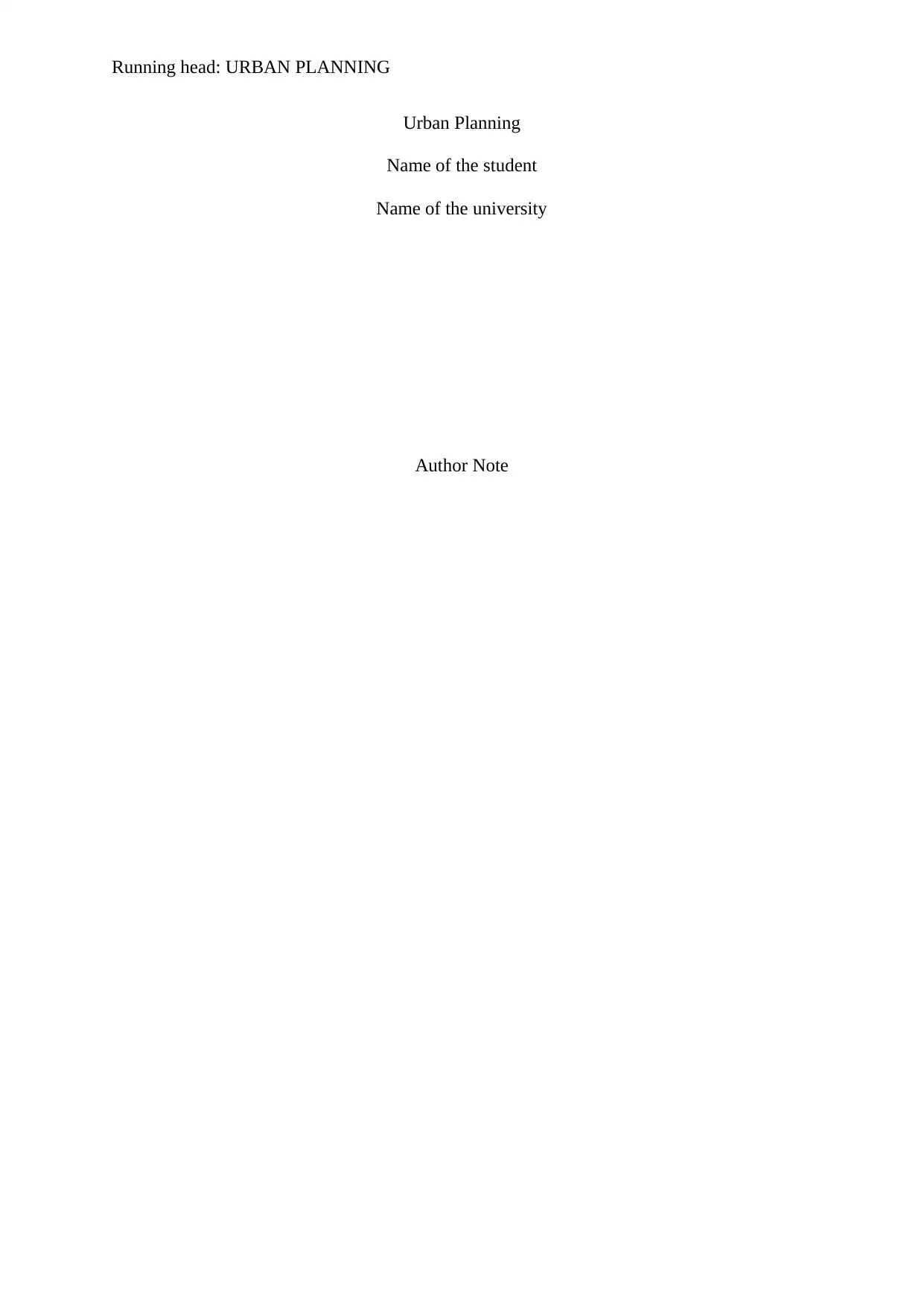
Running head: URBAN PLANNING
Urban Planning
Name of the student
Name of the university
Author Note
Urban Planning
Name of the student
Name of the university
Author Note
Paraphrase This Document
Need a fresh take? Get an instant paraphrase of this document with our AI Paraphraser
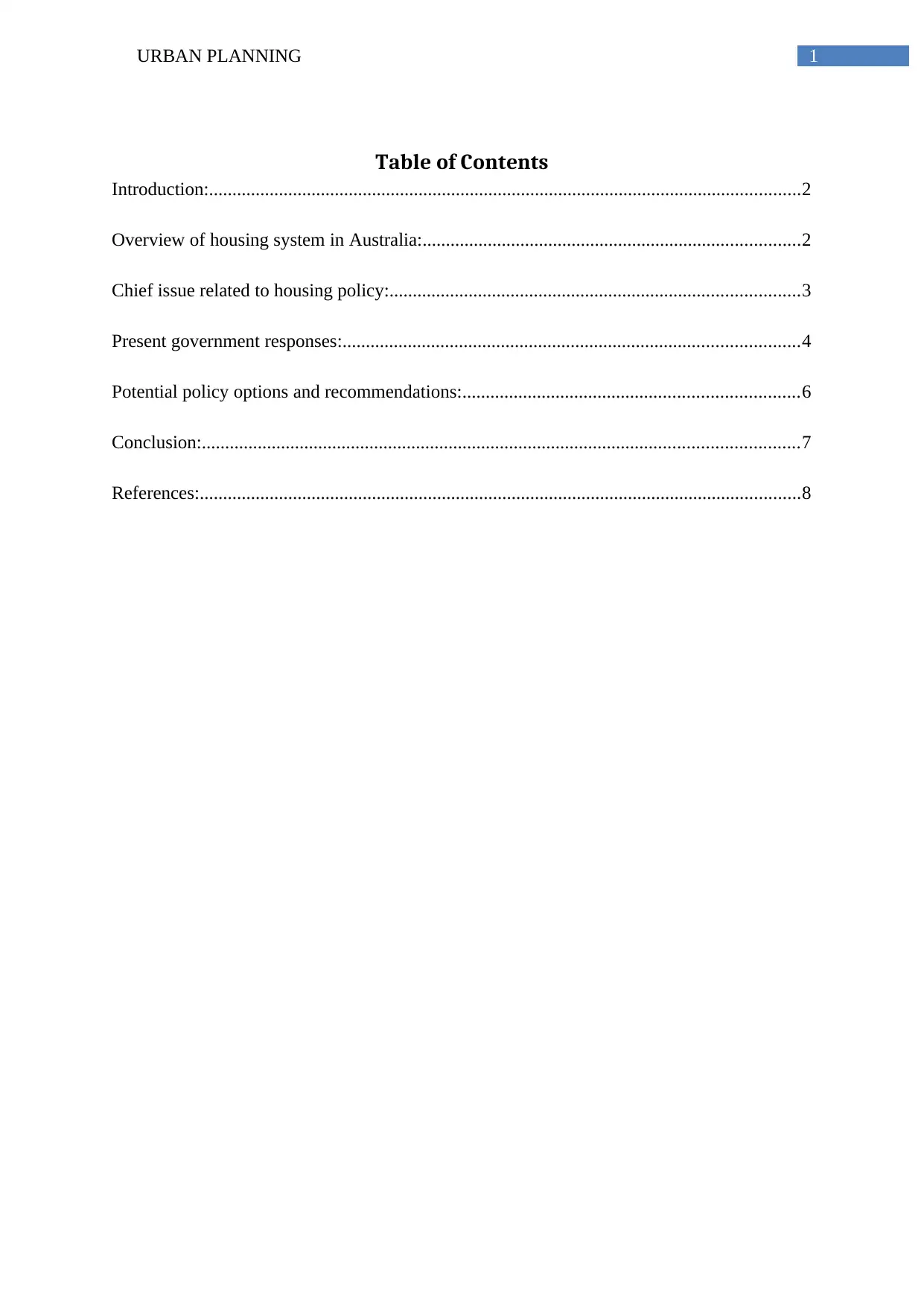
1URBAN PLANNING
Table of Contents
Introduction:...............................................................................................................................2
Overview of housing system in Australia:.................................................................................2
Chief issue related to housing policy:........................................................................................3
Present government responses:..................................................................................................4
Potential policy options and recommendations:........................................................................6
Conclusion:................................................................................................................................7
References:.................................................................................................................................8
Table of Contents
Introduction:...............................................................................................................................2
Overview of housing system in Australia:.................................................................................2
Chief issue related to housing policy:........................................................................................3
Present government responses:..................................................................................................4
Potential policy options and recommendations:........................................................................6
Conclusion:................................................................................................................................7
References:.................................................................................................................................8
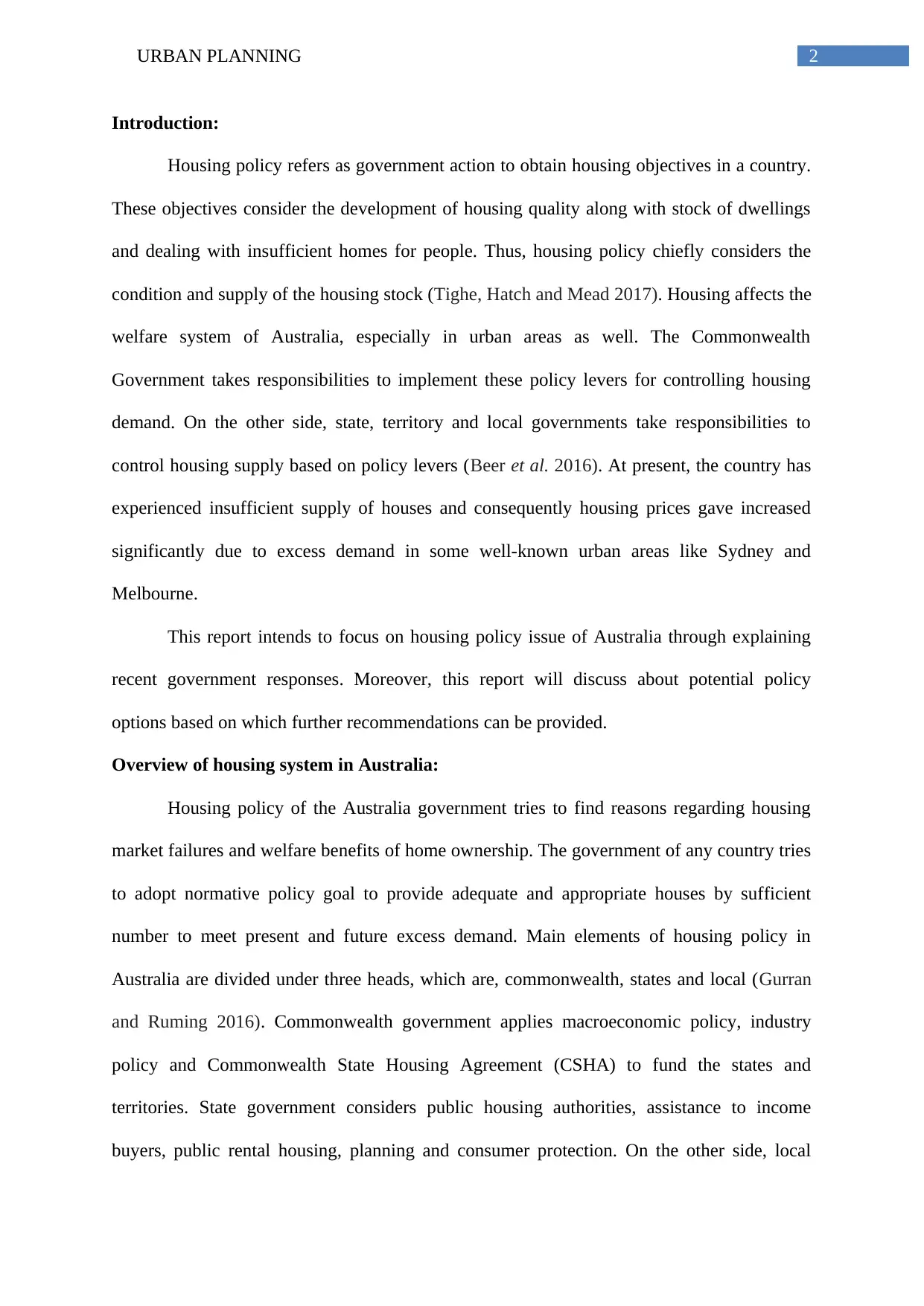
2URBAN PLANNING
Introduction:
Housing policy refers as government action to obtain housing objectives in a country.
These objectives consider the development of housing quality along with stock of dwellings
and dealing with insufficient homes for people. Thus, housing policy chiefly considers the
condition and supply of the housing stock (Tighe, Hatch and Mead 2017). Housing affects the
welfare system of Australia, especially in urban areas as well. The Commonwealth
Government takes responsibilities to implement these policy levers for controlling housing
demand. On the other side, state, territory and local governments take responsibilities to
control housing supply based on policy levers (Beer et al. 2016). At present, the country has
experienced insufficient supply of houses and consequently housing prices gave increased
significantly due to excess demand in some well-known urban areas like Sydney and
Melbourne.
This report intends to focus on housing policy issue of Australia through explaining
recent government responses. Moreover, this report will discuss about potential policy
options based on which further recommendations can be provided.
Overview of housing system in Australia:
Housing policy of the Australia government tries to find reasons regarding housing
market failures and welfare benefits of home ownership. The government of any country tries
to adopt normative policy goal to provide adequate and appropriate houses by sufficient
number to meet present and future excess demand. Main elements of housing policy in
Australia are divided under three heads, which are, commonwealth, states and local (Gurran
and Ruming 2016). Commonwealth government applies macroeconomic policy, industry
policy and Commonwealth State Housing Agreement (CSHA) to fund the states and
territories. State government considers public housing authorities, assistance to income
buyers, public rental housing, planning and consumer protection. On the other side, local
Introduction:
Housing policy refers as government action to obtain housing objectives in a country.
These objectives consider the development of housing quality along with stock of dwellings
and dealing with insufficient homes for people. Thus, housing policy chiefly considers the
condition and supply of the housing stock (Tighe, Hatch and Mead 2017). Housing affects the
welfare system of Australia, especially in urban areas as well. The Commonwealth
Government takes responsibilities to implement these policy levers for controlling housing
demand. On the other side, state, territory and local governments take responsibilities to
control housing supply based on policy levers (Beer et al. 2016). At present, the country has
experienced insufficient supply of houses and consequently housing prices gave increased
significantly due to excess demand in some well-known urban areas like Sydney and
Melbourne.
This report intends to focus on housing policy issue of Australia through explaining
recent government responses. Moreover, this report will discuss about potential policy
options based on which further recommendations can be provided.
Overview of housing system in Australia:
Housing policy of the Australia government tries to find reasons regarding housing
market failures and welfare benefits of home ownership. The government of any country tries
to adopt normative policy goal to provide adequate and appropriate houses by sufficient
number to meet present and future excess demand. Main elements of housing policy in
Australia are divided under three heads, which are, commonwealth, states and local (Gurran
and Ruming 2016). Commonwealth government applies macroeconomic policy, industry
policy and Commonwealth State Housing Agreement (CSHA) to fund the states and
territories. State government considers public housing authorities, assistance to income
buyers, public rental housing, planning and consumer protection. On the other side, local
⊘ This is a preview!⊘
Do you want full access?
Subscribe today to unlock all pages.

Trusted by 1+ million students worldwide
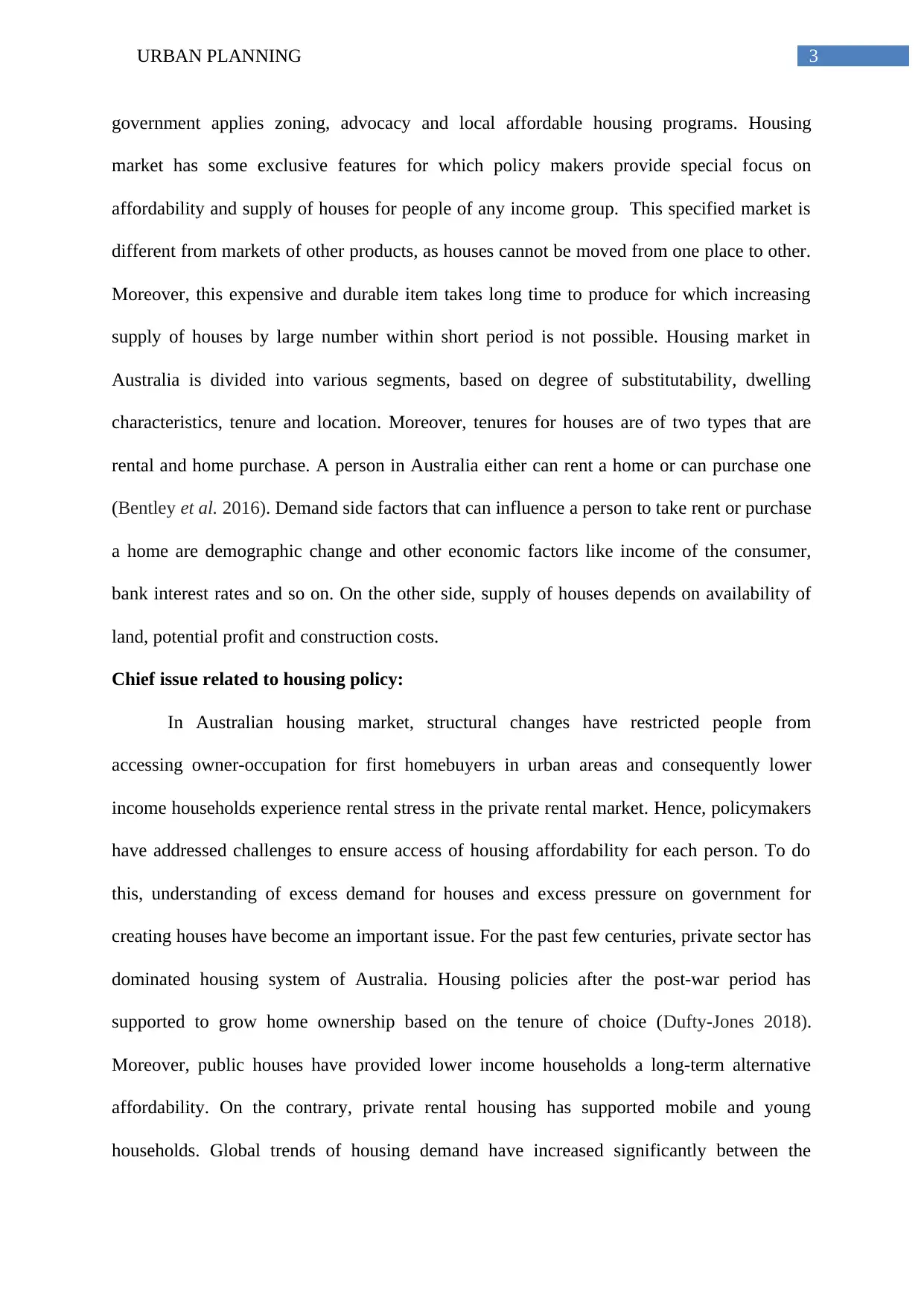
3URBAN PLANNING
government applies zoning, advocacy and local affordable housing programs. Housing
market has some exclusive features for which policy makers provide special focus on
affordability and supply of houses for people of any income group. This specified market is
different from markets of other products, as houses cannot be moved from one place to other.
Moreover, this expensive and durable item takes long time to produce for which increasing
supply of houses by large number within short period is not possible. Housing market in
Australia is divided into various segments, based on degree of substitutability, dwelling
characteristics, tenure and location. Moreover, tenures for houses are of two types that are
rental and home purchase. A person in Australia either can rent a home or can purchase one
(Bentley et al. 2016). Demand side factors that can influence a person to take rent or purchase
a home are demographic change and other economic factors like income of the consumer,
bank interest rates and so on. On the other side, supply of houses depends on availability of
land, potential profit and construction costs.
Chief issue related to housing policy:
In Australian housing market, structural changes have restricted people from
accessing owner-occupation for first homebuyers in urban areas and consequently lower
income households experience rental stress in the private rental market. Hence, policymakers
have addressed challenges to ensure access of housing affordability for each person. To do
this, understanding of excess demand for houses and excess pressure on government for
creating houses have become an important issue. For the past few centuries, private sector has
dominated housing system of Australia. Housing policies after the post-war period has
supported to grow home ownership based on the tenure of choice (Dufty-Jones 2018).
Moreover, public houses have provided lower income households a long-term alternative
affordability. On the contrary, private rental housing has supported mobile and young
households. Global trends of housing demand have increased significantly between the
government applies zoning, advocacy and local affordable housing programs. Housing
market has some exclusive features for which policy makers provide special focus on
affordability and supply of houses for people of any income group. This specified market is
different from markets of other products, as houses cannot be moved from one place to other.
Moreover, this expensive and durable item takes long time to produce for which increasing
supply of houses by large number within short period is not possible. Housing market in
Australia is divided into various segments, based on degree of substitutability, dwelling
characteristics, tenure and location. Moreover, tenures for houses are of two types that are
rental and home purchase. A person in Australia either can rent a home or can purchase one
(Bentley et al. 2016). Demand side factors that can influence a person to take rent or purchase
a home are demographic change and other economic factors like income of the consumer,
bank interest rates and so on. On the other side, supply of houses depends on availability of
land, potential profit and construction costs.
Chief issue related to housing policy:
In Australian housing market, structural changes have restricted people from
accessing owner-occupation for first homebuyers in urban areas and consequently lower
income households experience rental stress in the private rental market. Hence, policymakers
have addressed challenges to ensure access of housing affordability for each person. To do
this, understanding of excess demand for houses and excess pressure on government for
creating houses have become an important issue. For the past few centuries, private sector has
dominated housing system of Australia. Housing policies after the post-war period has
supported to grow home ownership based on the tenure of choice (Dufty-Jones 2018).
Moreover, public houses have provided lower income households a long-term alternative
affordability. On the contrary, private rental housing has supported mobile and young
households. Global trends of housing demand have increased significantly between the
Paraphrase This Document
Need a fresh take? Get an instant paraphrase of this document with our AI Paraphraser
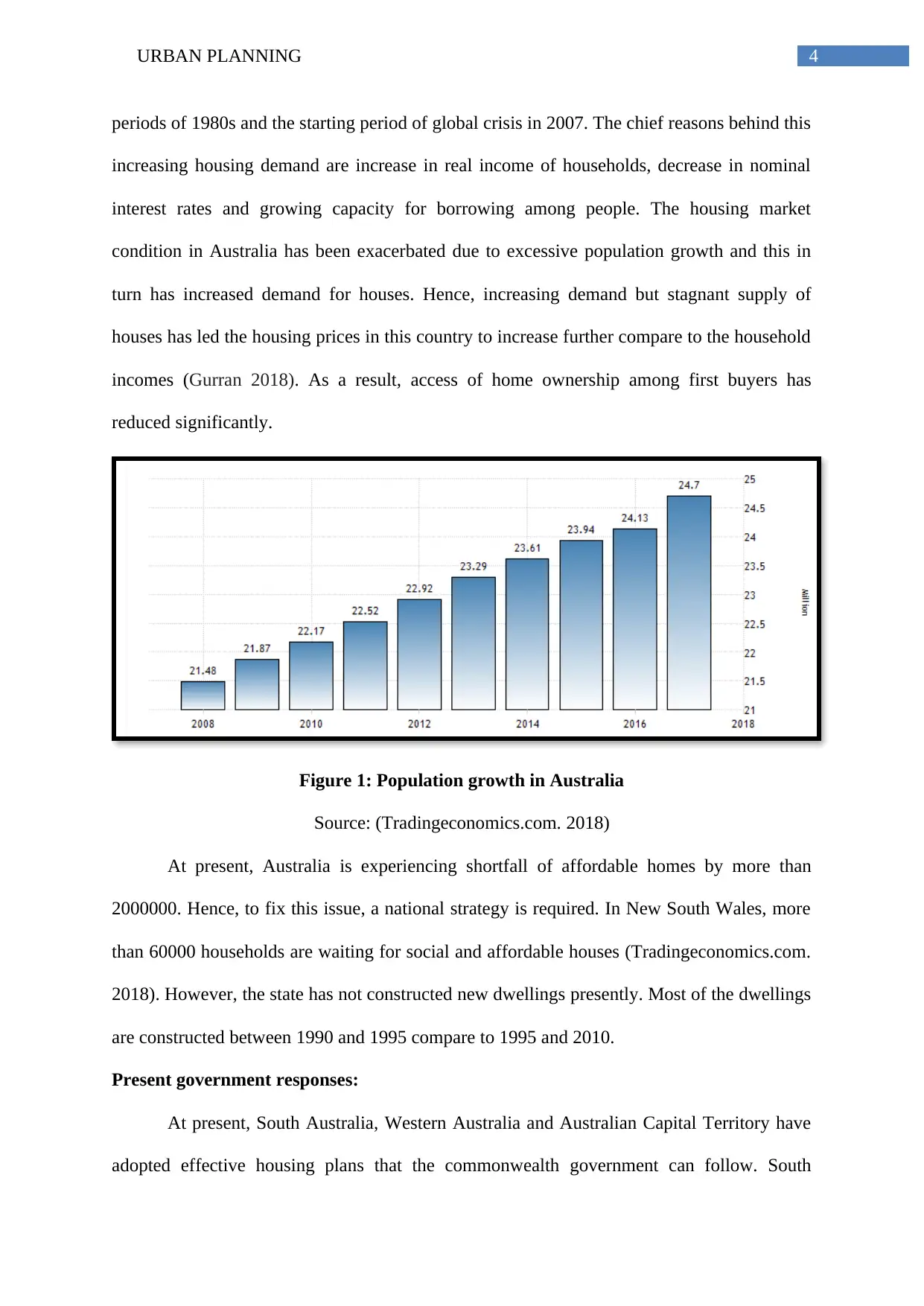
4URBAN PLANNING
periods of 1980s and the starting period of global crisis in 2007. The chief reasons behind this
increasing housing demand are increase in real income of households, decrease in nominal
interest rates and growing capacity for borrowing among people. The housing market
condition in Australia has been exacerbated due to excessive population growth and this in
turn has increased demand for houses. Hence, increasing demand but stagnant supply of
houses has led the housing prices in this country to increase further compare to the household
incomes (Gurran 2018). As a result, access of home ownership among first buyers has
reduced significantly.
Figure 1: Population growth in Australia
Source: (Tradingeconomics.com. 2018)
At present, Australia is experiencing shortfall of affordable homes by more than
2000000. Hence, to fix this issue, a national strategy is required. In New South Wales, more
than 60000 households are waiting for social and affordable houses (Tradingeconomics.com.
2018). However, the state has not constructed new dwellings presently. Most of the dwellings
are constructed between 1990 and 1995 compare to 1995 and 2010.
Present government responses:
At present, South Australia, Western Australia and Australian Capital Territory have
adopted effective housing plans that the commonwealth government can follow. South
periods of 1980s and the starting period of global crisis in 2007. The chief reasons behind this
increasing housing demand are increase in real income of households, decrease in nominal
interest rates and growing capacity for borrowing among people. The housing market
condition in Australia has been exacerbated due to excessive population growth and this in
turn has increased demand for houses. Hence, increasing demand but stagnant supply of
houses has led the housing prices in this country to increase further compare to the household
incomes (Gurran 2018). As a result, access of home ownership among first buyers has
reduced significantly.
Figure 1: Population growth in Australia
Source: (Tradingeconomics.com. 2018)
At present, Australia is experiencing shortfall of affordable homes by more than
2000000. Hence, to fix this issue, a national strategy is required. In New South Wales, more
than 60000 households are waiting for social and affordable houses (Tradingeconomics.com.
2018). However, the state has not constructed new dwellings presently. Most of the dwellings
are constructed between 1990 and 1995 compare to 1995 and 2010.
Present government responses:
At present, South Australia, Western Australia and Australian Capital Territory have
adopted effective housing plans that the commonwealth government can follow. South
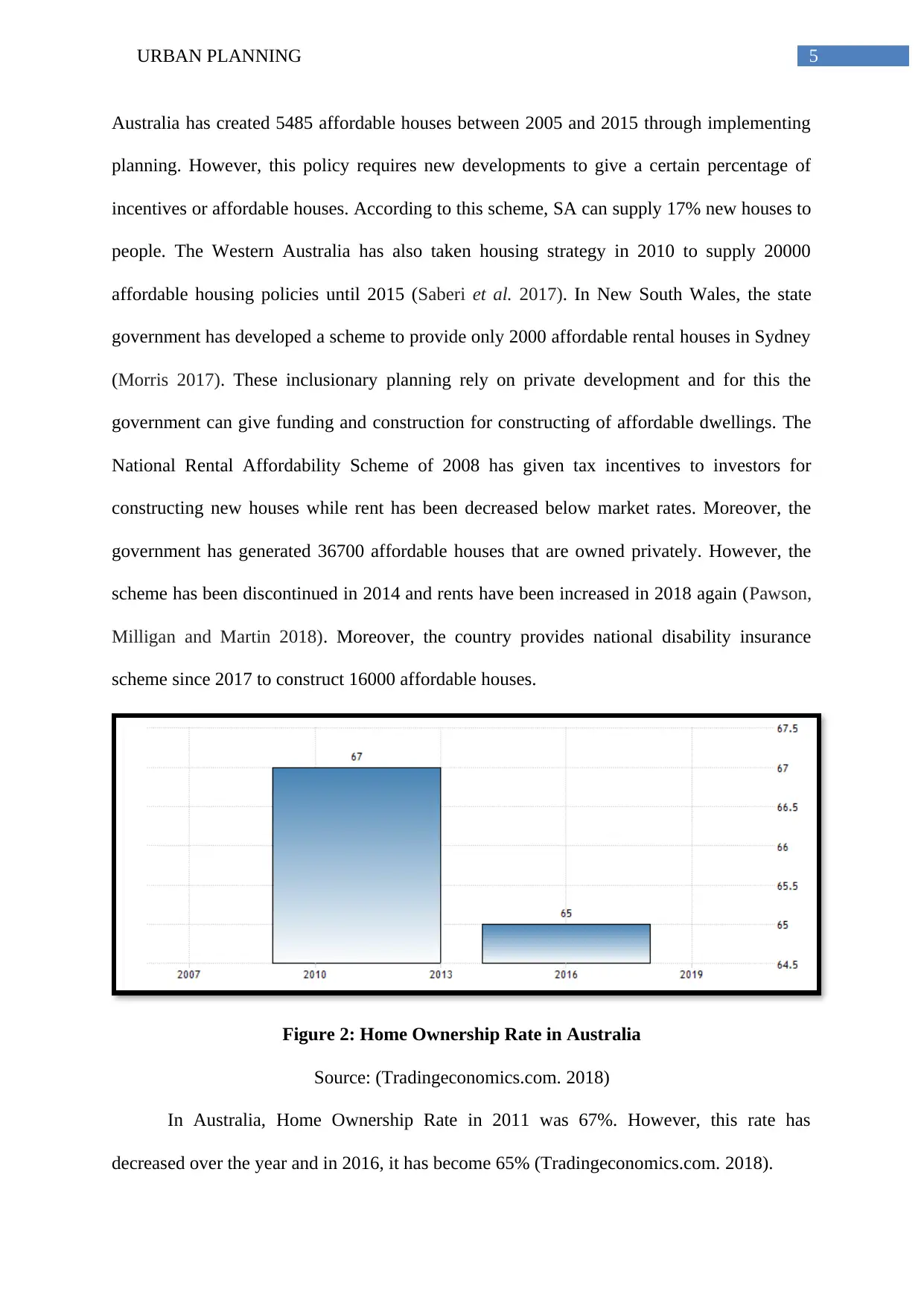
5URBAN PLANNING
Australia has created 5485 affordable houses between 2005 and 2015 through implementing
planning. However, this policy requires new developments to give a certain percentage of
incentives or affordable houses. According to this scheme, SA can supply 17% new houses to
people. The Western Australia has also taken housing strategy in 2010 to supply 20000
affordable housing policies until 2015 (Saberi et al. 2017). In New South Wales, the state
government has developed a scheme to provide only 2000 affordable rental houses in Sydney
(Morris 2017). These inclusionary planning rely on private development and for this the
government can give funding and construction for constructing of affordable dwellings. The
National Rental Affordability Scheme of 2008 has given tax incentives to investors for
constructing new houses while rent has been decreased below market rates. Moreover, the
government has generated 36700 affordable houses that are owned privately. However, the
scheme has been discontinued in 2014 and rents have been increased in 2018 again (Pawson,
Milligan and Martin 2018). Moreover, the country provides national disability insurance
scheme since 2017 to construct 16000 affordable houses.
Figure 2: Home Ownership Rate in Australia
Source: (Tradingeconomics.com. 2018)
In Australia, Home Ownership Rate in 2011 was 67%. However, this rate has
decreased over the year and in 2016, it has become 65% (Tradingeconomics.com. 2018).
Australia has created 5485 affordable houses between 2005 and 2015 through implementing
planning. However, this policy requires new developments to give a certain percentage of
incentives or affordable houses. According to this scheme, SA can supply 17% new houses to
people. The Western Australia has also taken housing strategy in 2010 to supply 20000
affordable housing policies until 2015 (Saberi et al. 2017). In New South Wales, the state
government has developed a scheme to provide only 2000 affordable rental houses in Sydney
(Morris 2017). These inclusionary planning rely on private development and for this the
government can give funding and construction for constructing of affordable dwellings. The
National Rental Affordability Scheme of 2008 has given tax incentives to investors for
constructing new houses while rent has been decreased below market rates. Moreover, the
government has generated 36700 affordable houses that are owned privately. However, the
scheme has been discontinued in 2014 and rents have been increased in 2018 again (Pawson,
Milligan and Martin 2018). Moreover, the country provides national disability insurance
scheme since 2017 to construct 16000 affordable houses.
Figure 2: Home Ownership Rate in Australia
Source: (Tradingeconomics.com. 2018)
In Australia, Home Ownership Rate in 2011 was 67%. However, this rate has
decreased over the year and in 2016, it has become 65% (Tradingeconomics.com. 2018).
⊘ This is a preview!⊘
Do you want full access?
Subscribe today to unlock all pages.

Trusted by 1+ million students worldwide
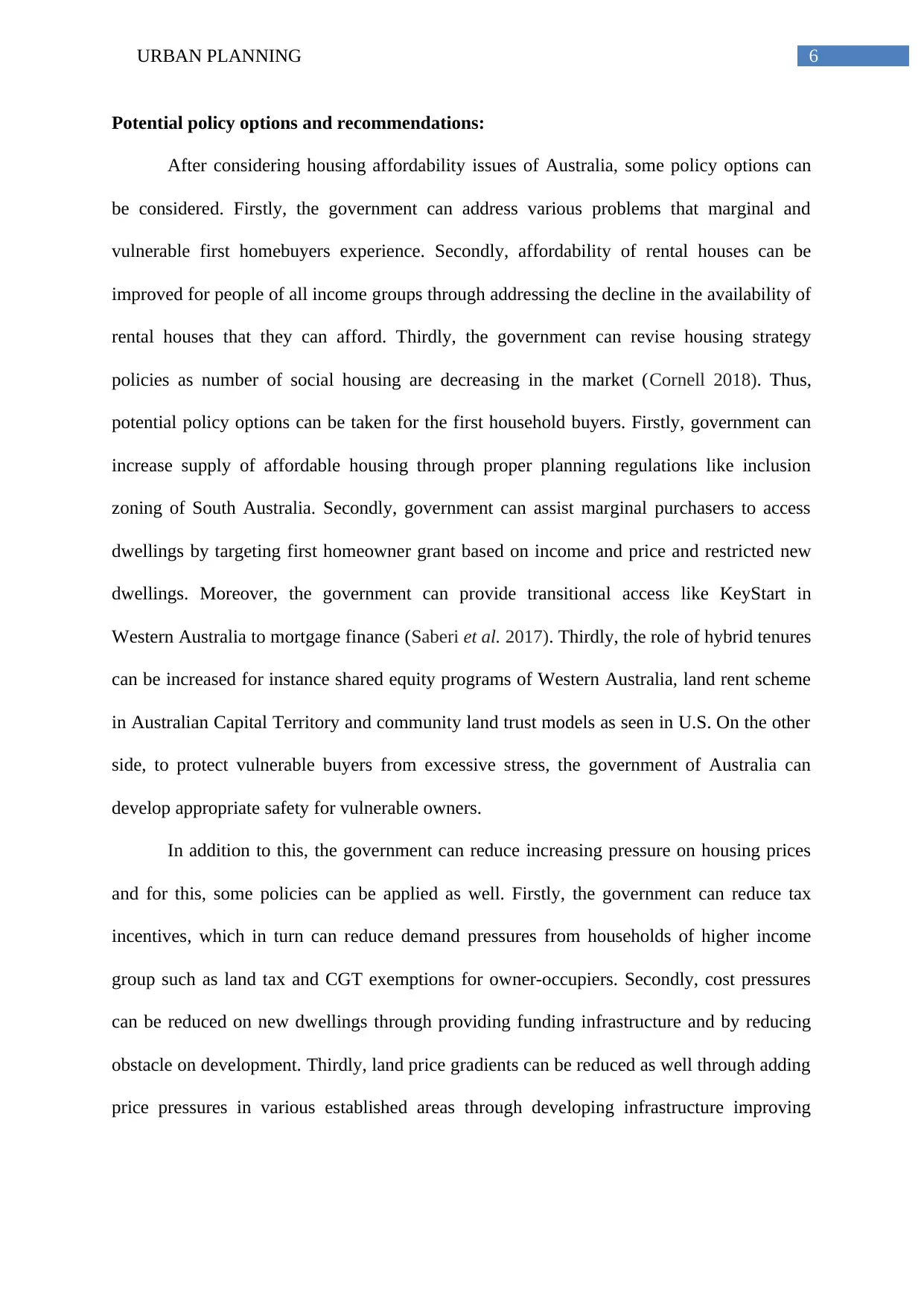
6URBAN PLANNING
Potential policy options and recommendations:
After considering housing affordability issues of Australia, some policy options can
be considered. Firstly, the government can address various problems that marginal and
vulnerable first homebuyers experience. Secondly, affordability of rental houses can be
improved for people of all income groups through addressing the decline in the availability of
rental houses that they can afford. Thirdly, the government can revise housing strategy
policies as number of social housing are decreasing in the market (Cornell 2018). Thus,
potential policy options can be taken for the first household buyers. Firstly, government can
increase supply of affordable housing through proper planning regulations like inclusion
zoning of South Australia. Secondly, government can assist marginal purchasers to access
dwellings by targeting first homeowner grant based on income and price and restricted new
dwellings. Moreover, the government can provide transitional access like KeyStart in
Western Australia to mortgage finance (Saberi et al. 2017). Thirdly, the role of hybrid tenures
can be increased for instance shared equity programs of Western Australia, land rent scheme
in Australian Capital Territory and community land trust models as seen in U.S. On the other
side, to protect vulnerable buyers from excessive stress, the government of Australia can
develop appropriate safety for vulnerable owners.
In addition to this, the government can reduce increasing pressure on housing prices
and for this, some policies can be applied as well. Firstly, the government can reduce tax
incentives, which in turn can reduce demand pressures from households of higher income
group such as land tax and CGT exemptions for owner-occupiers. Secondly, cost pressures
can be reduced on new dwellings through providing funding infrastructure and by reducing
obstacle on development. Thirdly, land price gradients can be reduced as well through adding
price pressures in various established areas through developing infrastructure improving
Potential policy options and recommendations:
After considering housing affordability issues of Australia, some policy options can
be considered. Firstly, the government can address various problems that marginal and
vulnerable first homebuyers experience. Secondly, affordability of rental houses can be
improved for people of all income groups through addressing the decline in the availability of
rental houses that they can afford. Thirdly, the government can revise housing strategy
policies as number of social housing are decreasing in the market (Cornell 2018). Thus,
potential policy options can be taken for the first household buyers. Firstly, government can
increase supply of affordable housing through proper planning regulations like inclusion
zoning of South Australia. Secondly, government can assist marginal purchasers to access
dwellings by targeting first homeowner grant based on income and price and restricted new
dwellings. Moreover, the government can provide transitional access like KeyStart in
Western Australia to mortgage finance (Saberi et al. 2017). Thirdly, the role of hybrid tenures
can be increased for instance shared equity programs of Western Australia, land rent scheme
in Australian Capital Territory and community land trust models as seen in U.S. On the other
side, to protect vulnerable buyers from excessive stress, the government of Australia can
develop appropriate safety for vulnerable owners.
In addition to this, the government can reduce increasing pressure on housing prices
and for this, some policies can be applied as well. Firstly, the government can reduce tax
incentives, which in turn can reduce demand pressures from households of higher income
group such as land tax and CGT exemptions for owner-occupiers. Secondly, cost pressures
can be reduced on new dwellings through providing funding infrastructure and by reducing
obstacle on development. Thirdly, land price gradients can be reduced as well through adding
price pressures in various established areas through developing infrastructure improving
Paraphrase This Document
Need a fresh take? Get an instant paraphrase of this document with our AI Paraphraser
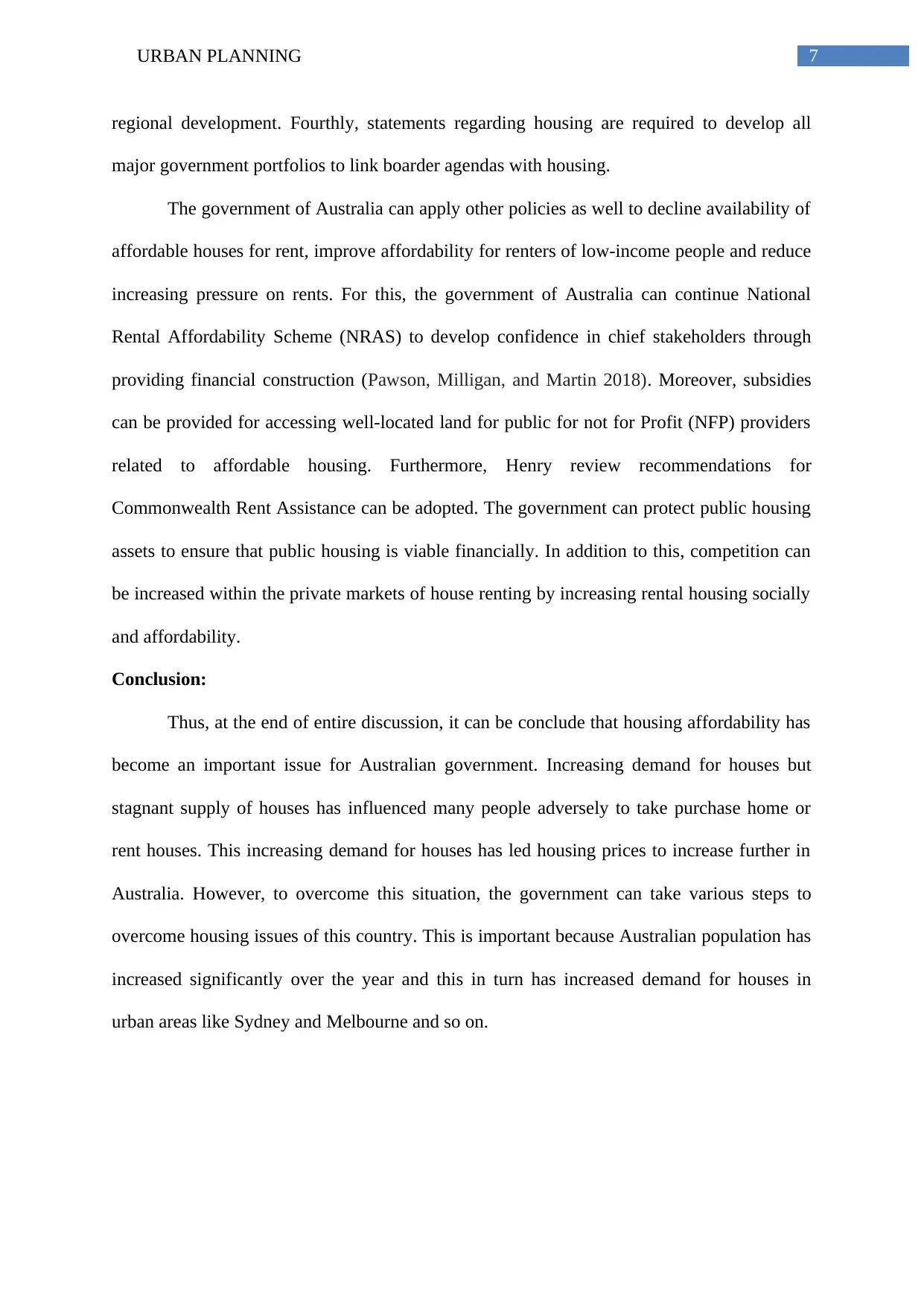
7URBAN PLANNING
regional development. Fourthly, statements regarding housing are required to develop all
major government portfolios to link boarder agendas with housing.
The government of Australia can apply other policies as well to decline availability of
affordable houses for rent, improve affordability for renters of low-income people and reduce
increasing pressure on rents. For this, the government of Australia can continue National
Rental Affordability Scheme (NRAS) to develop confidence in chief stakeholders through
providing financial construction (Pawson, Milligan, and Martin 2018). Moreover, subsidies
can be provided for accessing well-located land for public for not for Profit (NFP) providers
related to affordable housing. Furthermore, Henry review recommendations for
Commonwealth Rent Assistance can be adopted. The government can protect public housing
assets to ensure that public housing is viable financially. In addition to this, competition can
be increased within the private markets of house renting by increasing rental housing socially
and affordability.
Conclusion:
Thus, at the end of entire discussion, it can be conclude that housing affordability has
become an important issue for Australian government. Increasing demand for houses but
stagnant supply of houses has influenced many people adversely to take purchase home or
rent houses. This increasing demand for houses has led housing prices to increase further in
Australia. However, to overcome this situation, the government can take various steps to
overcome housing issues of this country. This is important because Australian population has
increased significantly over the year and this in turn has increased demand for houses in
urban areas like Sydney and Melbourne and so on.
regional development. Fourthly, statements regarding housing are required to develop all
major government portfolios to link boarder agendas with housing.
The government of Australia can apply other policies as well to decline availability of
affordable houses for rent, improve affordability for renters of low-income people and reduce
increasing pressure on rents. For this, the government of Australia can continue National
Rental Affordability Scheme (NRAS) to develop confidence in chief stakeholders through
providing financial construction (Pawson, Milligan, and Martin 2018). Moreover, subsidies
can be provided for accessing well-located land for public for not for Profit (NFP) providers
related to affordable housing. Furthermore, Henry review recommendations for
Commonwealth Rent Assistance can be adopted. The government can protect public housing
assets to ensure that public housing is viable financially. In addition to this, competition can
be increased within the private markets of house renting by increasing rental housing socially
and affordability.
Conclusion:
Thus, at the end of entire discussion, it can be conclude that housing affordability has
become an important issue for Australian government. Increasing demand for houses but
stagnant supply of houses has influenced many people adversely to take purchase home or
rent houses. This increasing demand for houses has led housing prices to increase further in
Australia. However, to overcome this situation, the government can take various steps to
overcome housing issues of this country. This is important because Australian population has
increased significantly over the year and this in turn has increased demand for houses in
urban areas like Sydney and Melbourne and so on.
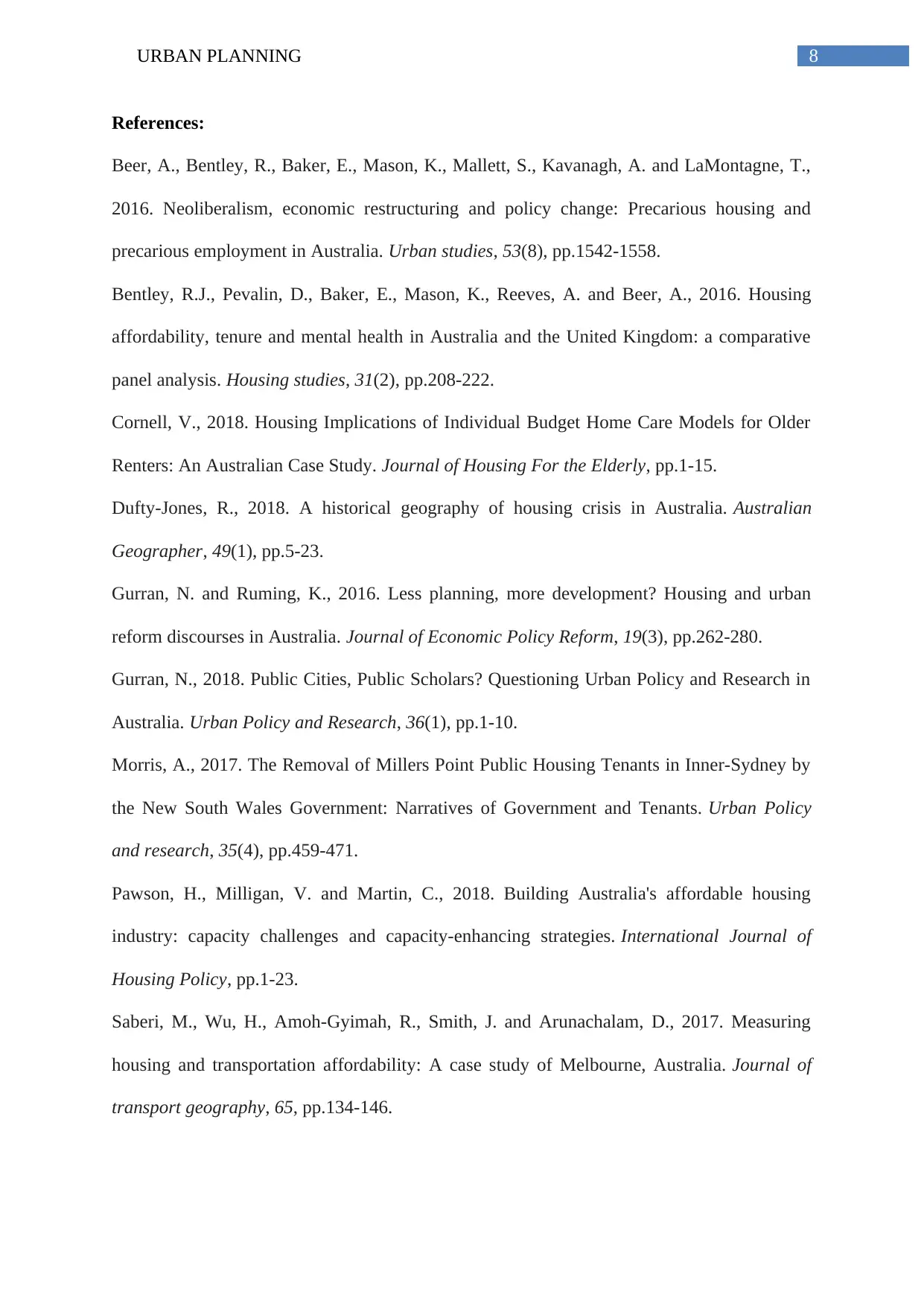
8URBAN PLANNING
References:
Beer, A., Bentley, R., Baker, E., Mason, K., Mallett, S., Kavanagh, A. and LaMontagne, T.,
2016. Neoliberalism, economic restructuring and policy change: Precarious housing and
precarious employment in Australia. Urban studies, 53(8), pp.1542-1558.
Bentley, R.J., Pevalin, D., Baker, E., Mason, K., Reeves, A. and Beer, A., 2016. Housing
affordability, tenure and mental health in Australia and the United Kingdom: a comparative
panel analysis. Housing studies, 31(2), pp.208-222.
Cornell, V., 2018. Housing Implications of Individual Budget Home Care Models for Older
Renters: An Australian Case Study. Journal of Housing For the Elderly, pp.1-15.
Dufty-Jones, R., 2018. A historical geography of housing crisis in Australia. Australian
Geographer, 49(1), pp.5-23.
Gurran, N. and Ruming, K., 2016. Less planning, more development? Housing and urban
reform discourses in Australia. Journal of Economic Policy Reform, 19(3), pp.262-280.
Gurran, N., 2018. Public Cities, Public Scholars? Questioning Urban Policy and Research in
Australia. Urban Policy and Research, 36(1), pp.1-10.
Morris, A., 2017. The Removal of Millers Point Public Housing Tenants in Inner-Sydney by
the New South Wales Government: Narratives of Government and Tenants. Urban Policy
and research, 35(4), pp.459-471.
Pawson, H., Milligan, V. and Martin, C., 2018. Building Australia's affordable housing
industry: capacity challenges and capacity-enhancing strategies. International Journal of
Housing Policy, pp.1-23.
Saberi, M., Wu, H., Amoh-Gyimah, R., Smith, J. and Arunachalam, D., 2017. Measuring
housing and transportation affordability: A case study of Melbourne, Australia. Journal of
transport geography, 65, pp.134-146.
References:
Beer, A., Bentley, R., Baker, E., Mason, K., Mallett, S., Kavanagh, A. and LaMontagne, T.,
2016. Neoliberalism, economic restructuring and policy change: Precarious housing and
precarious employment in Australia. Urban studies, 53(8), pp.1542-1558.
Bentley, R.J., Pevalin, D., Baker, E., Mason, K., Reeves, A. and Beer, A., 2016. Housing
affordability, tenure and mental health in Australia and the United Kingdom: a comparative
panel analysis. Housing studies, 31(2), pp.208-222.
Cornell, V., 2018. Housing Implications of Individual Budget Home Care Models for Older
Renters: An Australian Case Study. Journal of Housing For the Elderly, pp.1-15.
Dufty-Jones, R., 2018. A historical geography of housing crisis in Australia. Australian
Geographer, 49(1), pp.5-23.
Gurran, N. and Ruming, K., 2016. Less planning, more development? Housing and urban
reform discourses in Australia. Journal of Economic Policy Reform, 19(3), pp.262-280.
Gurran, N., 2018. Public Cities, Public Scholars? Questioning Urban Policy and Research in
Australia. Urban Policy and Research, 36(1), pp.1-10.
Morris, A., 2017. The Removal of Millers Point Public Housing Tenants in Inner-Sydney by
the New South Wales Government: Narratives of Government and Tenants. Urban Policy
and research, 35(4), pp.459-471.
Pawson, H., Milligan, V. and Martin, C., 2018. Building Australia's affordable housing
industry: capacity challenges and capacity-enhancing strategies. International Journal of
Housing Policy, pp.1-23.
Saberi, M., Wu, H., Amoh-Gyimah, R., Smith, J. and Arunachalam, D., 2017. Measuring
housing and transportation affordability: A case study of Melbourne, Australia. Journal of
transport geography, 65, pp.134-146.
⊘ This is a preview!⊘
Do you want full access?
Subscribe today to unlock all pages.

Trusted by 1+ million students worldwide
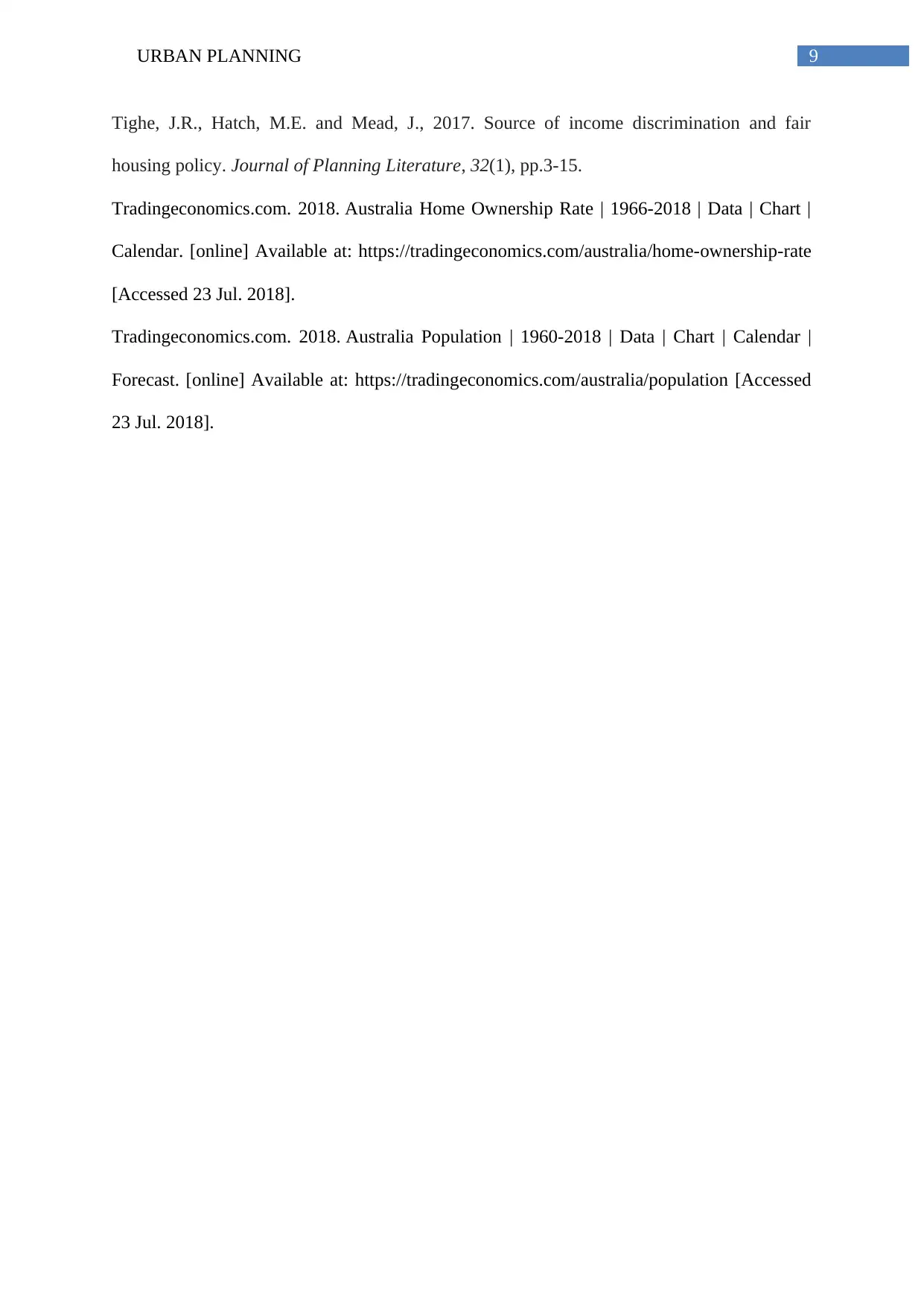
9URBAN PLANNING
Tighe, J.R., Hatch, M.E. and Mead, J., 2017. Source of income discrimination and fair
housing policy. Journal of Planning Literature, 32(1), pp.3-15.
Tradingeconomics.com. 2018. Australia Home Ownership Rate | 1966-2018 | Data | Chart |
Calendar. [online] Available at: https://tradingeconomics.com/australia/home-ownership-rate
[Accessed 23 Jul. 2018].
Tradingeconomics.com. 2018. Australia Population | 1960-2018 | Data | Chart | Calendar |
Forecast. [online] Available at: https://tradingeconomics.com/australia/population [Accessed
23 Jul. 2018].
Tighe, J.R., Hatch, M.E. and Mead, J., 2017. Source of income discrimination and fair
housing policy. Journal of Planning Literature, 32(1), pp.3-15.
Tradingeconomics.com. 2018. Australia Home Ownership Rate | 1966-2018 | Data | Chart |
Calendar. [online] Available at: https://tradingeconomics.com/australia/home-ownership-rate
[Accessed 23 Jul. 2018].
Tradingeconomics.com. 2018. Australia Population | 1960-2018 | Data | Chart | Calendar |
Forecast. [online] Available at: https://tradingeconomics.com/australia/population [Accessed
23 Jul. 2018].
1 out of 10
Related Documents
Your All-in-One AI-Powered Toolkit for Academic Success.
+13062052269
info@desklib.com
Available 24*7 on WhatsApp / Email
![[object Object]](/_next/static/media/star-bottom.7253800d.svg)
Unlock your academic potential
Copyright © 2020–2025 A2Z Services. All Rights Reserved. Developed and managed by ZUCOL.




